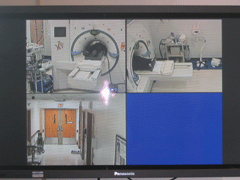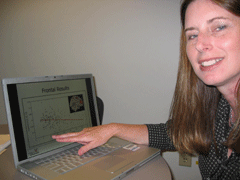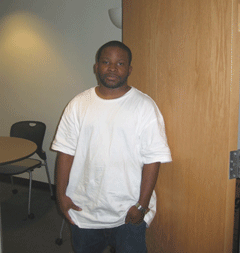Lead and Violent Crime
Air Date: Week of January 2, 2009

For the past three decades, researchers from the University of Cincinnati have been following 240 people from predominately African American neighborhoods of Cincinnati with high lead contamination. With each passing year, more is revealed about how lead in the environment affects health and behavior. Now, new research reveals that, even at low levels, lead exposure in early development shrinks key areas of the brain, and is linked with violent crime. Living on Earth’s Ashley Ahearn traveled to Cincinnati and has our story.
Transcript
CURWOOD: Lead is a neurotoxin, linked to disorders such as lower IQ and Attention Deficit Hyperactivity Disorder. And now there is more compelling evidence linking lead exposure in the womb and early childhood with violent crime later in life.
These latest findings come from researchers at the University of Cincinnati and Cincinnati Children’s Hospital. For almost three decades they have been following a group of Cincinnati residents – more than 90 percent of them African American. They grew up in neighborhoods with high lead contamination – mostly from the dust of deteriorated lead paint in older apartments and houses.
Living on Earth’s Ashley Ahearn reports.
[SUNDAY MORNING CHURCH SINGING]
AHEARN: It’s Sunday morning and city council member Cecil Thomas is here at Christ Emmanuel Church - where he comes for his weekly dose of hope and renewal. Serving as a police officer for 27 years in Cincinnati, Councilman Thomas watched the violence grow, seemingly without rhyme or reason. The new lead research gives him one potential explanation.
THOMAS: The environment as a totality really pretty much dictates a lot of our problems as relates to crime and things of that nature. Because when you look at areas of our city that are most affected by crime and then you look at buildings that are tainted with lead poisoning paint, then you have to start thinking well maybe there is a link between the effects of lead poising and the overall crime rates, especially in the inner city neighborhoods.
AHEARN: Cecil Thomas knew it was time to make the jump from police work to politics when he started arresting the kids and grandkids of folks he had arrested years before. He says the findings of the Cincinnati Lead Study offer a key avenue to understanding the violence he saw during his time on patrol.
THOMAS: If lead poisoning has a direct impact on the ability to make decisions in a much more rational way, then we are on to something, so to speak. I been a law enforcement officer, some of the times I would say “what’s missing here?” I recall an individual was on his way to the symphony and a young man came up to rob him but it wasn’t enough just to rob him, he then beat him to death with a brick. Now this young man was a product of that environment because he lived down in the Over the Rhine [neighborhood] so you have to ask yourself, ‘well was lead poisoning a factor in this individual committing such a crime?’
[CHURCH SOUNDS]

Kim Dietrich, Professor of Environmental Health at the University of Cincinnati, has been working with the lead study participants for almost thirty years, finding correlations between lead exposure and abnormal social behaviors, and now violent crime. (photo: Ashley Ahearn)
AHEARN: Dr. Kim Dietrich and his team at the University of Cincinnati are working to answer just that question. They took the criminal records of the 250 study participants and compared the numbers of violent crimes with the levels of lead each participant had been exposed to throughout his or her life.
DIETRICH: What we found was interesting. The most robust and significant associations were between early exposure to lead and arrests involving violent acts, some sort of violent aggressive behavior.
AHEARN: But they needed the “why”. What might lead be doing, on the physical level, to the brain to cause this violent aggressive behavior?
[MRI SOUNDS]
AHEARN: At Cincinnati Children’s Hospital, Damon’s lying inside the giant white cylinder of the MRI machine as it takes thousands of pictures of his brain.
[MRI SOUNDS]
AHEARN: Damon grew up in Over the Rhine, a neighborhood of downtown Cincinnati where rundown brick buildings line the streets, many of them contaminated with lead paint. He’s been participating in the Cincinnati Lead Study since before he was born. Now he’s 28.

The MRI machine at Cincinnati Children’s Hospital takes thousands of pictures of Damon’s brain to find out what parts are affected by lead exposure.
(photo: Ashley Ahearn)
DAMON: I remember the cab rides, the trips with my mama. It’s just something I been doing since I was a little boy and it continues.
AHEARN: The lead Damon was exposed to may have affected the size of certain parts of his brain – the frontal lobe in particular.
CECIL: The frontal lobe is probably the part that makes us the most human in that it’s executive functioning, attention, inhibition, reasoning, judgment, kind of overall control.
AHEARN: Dr. Kim Cecil is a professor of radiology at the University of Cincinnati and works with Dr. Dietrich. She’s found that children with higher lead levels have smaller frontal lobes as they reach adulthood. She says that may be because lead takes the place of calcium in the brain.

Kim Cecil, Professor of Radiology at the University of Cincinnati shows the correlation between lead exposure and brain volume loss. She says lead acts like calcium in the brain, preventing the maintenance of healthy neurons.(photo: Ashley Ahearn)
CECIL: It interferes with many enzymes that preserve the neurons in the brain so it stops the healthy maintenance of neurons and thus neurons can die. And it looks like a shriveled up brain. So in a way it looks like a person who’s much, much older.
AHEARN: Older - as in closer to senility - not older - as in more mature. Young men, like Damon, show more volume loss to the frontal lobe than young women exposed to similar levels of lead.
But women are by no means exempt from lead’s effects. Like Damon, Laquisha’s been participating in the lead study her whole life. It started with her mom taking her to regular appointments at Cincinnati Children’s Hospital.
[SHAWTY LO HIP HOP IN BACKGROUND]
LAQUISHA: Ma, C’mere.
[TEA CUP STIRRING]
MOM: It wasn’t easy as a matter of fact. I was living Over the Rhine, downtown, in the rehab. It was the paint chippings from the window. They let me know that she had lead poisoning. They did tell me that her lead level was so high they almost had to hospitalize her at one point.

Damon is a participant in the Cincinnati Lead Study, which is linking lead exposure with volume loss in the prefrontal cortex of the brain, especially in men.(photo: Ashley Ahearn)
She been hell on wheels, Ok.
[SHAWTY LO FADES UP]
LAQUISHA: This is Shawty Lo, one of my favorite rappers, cuz he be keepin it real (singing along)
[SHAWTY LO FADES OUT]
LAQUISHA: I wasn’t like the other kids. I won’t catch on as quick as them. Like I can’t concentrate on one thing too long.
I tend, like when stuff doesn’t go my way or whatever, like, sometimes I tend to want to hurt myself or other people. When I couldn’t get my way, I like tear down the whole bedroom, I break mirrors, and everything, I pull all my hair out. And then at the end I be wishin’ I never did it. Like when I went to prison for hitting that police officer, I didn't really mean to hit him, it was just I don’t know.
Me and my old boyfriend, we was downtown at a restaurant, at Arby’s. And he was ordering his food and the same cashier always get his order wrong. So he told her, "Give my money back, I’m tired of you, every time I come here you get my order wrong."
So they was just going back and forth, and the police was in there and when he grabbed me he slapped one handcuff on me and I was goin’ crazy. I was kickin’ screamin’. I wouldn’t let him get the other handcuff on me. So he slammed me and came down with his other knee in my stomach. So I grabbed his belt and the collar of his shirt and I flipped him on his head and I was hitting him with my handcuff that was free and then somehow he got me in a headlock. He was punchin’ me in my head, we was just exchangin’.

Laquisha (center) with co-workers at McDonalds. She has been participating in the Cincinnati Lead Study since she was a year old and says lead exposure has affected her behavior, with some serious consequences. (photo: Ashley Ahearn)
At that point in time I just wasn’t thinkin’. And that got me two years in prison. My first time ever bein’ in trouble. Eighteen. It feel like you ain’t never goin’ nowhere, when your time gonna come.
[INSTRUMENTAL]
MOM: She got a very short temper, very short attention span. Don’t nothin’ hold her interest for too long, nothin’. But I tell you what she can do for hours and hours. She can just sit up and write for hours and hours. She loves to write.
[PAPERS TURNING]
LAQUISHA: I got a lot of stuff that I used to write. And when I wrote this I was in Mary’s View.
MOM: Women’s prison.
LAQUISHA: It’s a women’s prison. I was 20 years, I was probably almost on my way home. I don’t know, I just used to write so many and I didn’t put no dates on them. But this one, it say:
Hey I’m only 20 years old. I’m in prison because I fail to realize how much I love my family and how memories can hurt. I miss bein’ eight years old, when I come home from school the sound of my father’s car pickin’ me up. I miss watching cartoons with my big brother every morning before we go to school. I miss the smell of my cheeks that I used to wipe away when my mom would kiss me. I miss my brother brushin’ my hair when I was little. I miss the knob opening my bedroom when my mom come home from work. There’s no way I can tell you all the reasons not to come to prison and how to stay out of trouble on one page but I can tell you this: The next time your grandma or mom kisses you and leaves lipstick on your cheeks, don’t wipe it off, you might regret it in years to come.
That’s just the type of stuff that I used to write.
And uh, see these, these obituaries of my friends that passed. This my friend, Mama, her name is Bedra. We call her Miss Betty. Her and my friend ‘Lil Rodney got killed together, somebody, she had opened her door and somebody had shot her and came in her house and shot everybody else that was in there.

S. Gregory Baker, Director of Community Relations at the Cincinnati Police Department, says officers on duty can’t tell if someone has been exposed to lead, even if it may be partially causing them to commit violent acts of crime.
(photo: Ashley Ahearn)
AHEARN: Of the 250 people in the Cincinnati Lead Study Laquisha takes part in, nine have been killed in violent crime. To put that in perspective, this group is 650 times more likely to die in violent crime than the average American.
[SOUND IN CHURCH]
AHEARN: Sitting in a pew after the service at Christ Emmanuel Church, Councilmember Cecil Thomas says that from his perspective, homicide and lead exposure seem to go hand in hand. But there’s something else in the mix. It’s no surprise to him that less than half of the study participants finished high school.
THOMAS: Eighty percent of individuals that committed homicides did not finish high school and 75 percent of the victims had not finished high school so there was a direct link between the education and violence. Then you go back to the question of, "well why is that young man not finishing school. Has the lead poisoning affected his ability to learn?" So when we start looking at lead poisoning yes we are looking at maybe one of the causative factors to violence in our city.
AHEARN: Lead exposure levels have gone down in Americans of all races, but African American children are still twice as likely as white children to suffer from lead poisoning, thanks to housing patterns and poor nutrition. And with statistics showing black men as likely to go to jail as to go to college, this latest research linking violent crime and lead raises key questions for society.
There are many factors behind violence—home life, education, easy access to drugs and weapons… But a growing body of scientific evidence suggests lead also belongs on that list. Dr. Kim Dietrich of the University of Cincinnati likes to say that lead may not be the “gun,” so to speak, but it appears to be one factor that’s helping to pull the trigger.
For Living on Earth, I’m Ashley Ahearn in Cincinnati, Ohio.
Links
Kim Cecil’s study: “Decreased Brain Volume in Adults with Childhood Lead Exposure.”
Living on Earth wants to hear from you!
Living on Earth
62 Calef Highway, Suite 212
Lee, NH 03861
Telephone: 617-287-4121
E-mail: comments@loe.org
Newsletter [Click here]
Donate to Living on Earth!
Living on Earth is an independent media program and relies entirely on contributions from listeners and institutions supporting public service. Please donate now to preserve an independent environmental voice.
NewsletterLiving on Earth offers a weekly delivery of the show's rundown to your mailbox. Sign up for our newsletter today!
 Sailors For The Sea: Be the change you want to sea.
Sailors For The Sea: Be the change you want to sea.
 The Grantham Foundation for the Protection of the Environment: Committed to protecting and improving the health of the global environment.
The Grantham Foundation for the Protection of the Environment: Committed to protecting and improving the health of the global environment.
 Contribute to Living on Earth and receive, as our gift to you, an archival print of one of Mark Seth Lender's extraordinary wildlife photographs. Follow the link to see Mark's current collection of photographs.
Contribute to Living on Earth and receive, as our gift to you, an archival print of one of Mark Seth Lender's extraordinary wildlife photographs. Follow the link to see Mark's current collection of photographs.
 Buy a signed copy of Mark Seth Lender's book Smeagull the Seagull & support Living on Earth
Buy a signed copy of Mark Seth Lender's book Smeagull the Seagull & support Living on Earth

